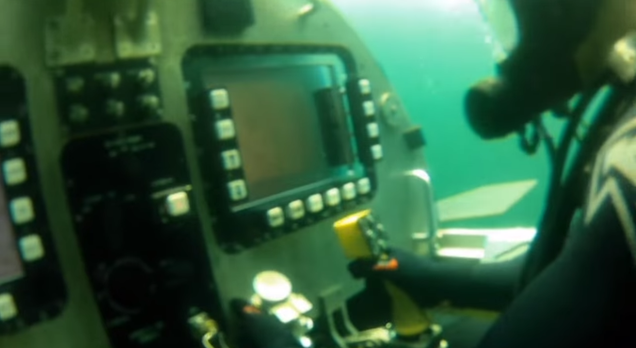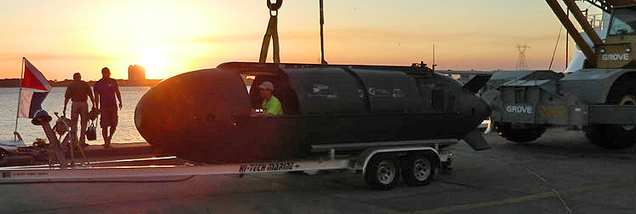30 July 2015
U.S. Navy SEALs have to infiltrate and exfiltrate from some of the most hostile areas on earth, and often times they travel underwater to do so. The Mark 8 SEAL Delivery Vehicle (SDV) has been used in various configurations for decades for this mission, and after previous tries to replace it, a group with an incredible maritime tech pedigree thinks they have the solution.
Meet Proteus, the brainchild of Huntington Ingalls Underwater Solutions Group, Bluefin Robotics and Battelle. This streamlined mini-sub goes far beyond being just another swimmer delivery vehicle, it is a “dual-mode” vehicle that can operate manned or unmanned for a wide array of missions.

The concept came out of a previous Large Displacement Unmanned Underwater Vehicle (LDUUV) imitative that the Office Of Naval Research was, and still is working on. As the large underwater drone developed, it became clear to Huntington Ingalls that is was big enough to be turned into an optionally manned platform similar in size to the Seal Delivery Vehicle that had been built for years.
Because of its similar size and ‘wet’ configuration as the long-used SDV, a Proteus like design could allow U.S. fast attack and guided missile Submarines equipped with dry-dock shelters to be able to carry a large unmanned submersible and a frogman delivery vehicle in one package, not having to choose between one or the other.
Proteus weighs just over 8,000 pounds, and can deliver six (possibly more) fully equipped frogmen to their destination over a range of 350 to 700 miles depending on the batteries used. It has a top speed of 10 knots and cruises at 8 knots, and is equipped with multi-beam sonar for avoidance and navigation. It operates at a disclosed maximum unmanned depth of 200 feet, or 150 feet with divers on-board.
The slick little sub is equipped with a pair of low-profile masts that fold down onto its dorsal spine. These can be equipped with imaging sensors, communications antennas and navigational arrays, or they can be outfitted for with advanced eavesdropping and spying equipment. The center section of Proteus can be equipped with a large bay that can hold 3,600 pounds of equipment and can lower that equipment to the seafloor.
What is interesting about Proteus is that it takes the same proven and relatively simple “wet” design concept as the SDV, but packages it into a more streamlined and much more adaptable package. In the past, attempts to replace the SDV have been made, largely focusing on creating a complex “dry interior” design, where SEALs would basically board the mini-submarine and exit through an airlock. This greatly increased complexity and cost and changed the already established logistics footprint used by the proven SDV.

Years of development led to the Advanced SEAL Delivery System (ASDS) in the 2000s, an ambitious mini-sub that would provide a massive increase in capability over the SDV, but at a huge cost. The comparatively huge, 16 man ASDS was plagued with issues during testing, and its cost skyrocketed. Eventually a catastrophic fire led to the program’s final demise in 2008. Meanwhile, the ever upgraded Mark 8 SEAL Delivery Vehicle soldiered on.
Seeing the embarrassment of the ambitious ASDS program, Proteus may just be the right mix of new capability and low-risk, proven design and operations philosophy for it to make sense for the Navy to buy. Keep in mind this doesn’t even account for the submersible’s unmanned capability, which could be game changing.
The fact that Proteus can operate autonomously is an amazing capability to ponder as it opens up a wide new concept of operations while still utilizing the same logistics footprint as the SEAL Swimmer Delivery Vehicle. While even the Mark 8 SDV has some unmanned functions, where it can loiter in wait for the SEALs to return from a mission, Proteus is a much smarter and more adaptable machine, able to be outfitted for a variety of missions. These include transporting and installing equipment on the sea floor, mine detection, inspecting undersea infrastructure, spying and transporting divers and bulk cargo. Basically, it can go from driving SEALs into combat to becoming a autonomous sensor truck and equipment truck. This means not only can Proteus resupply SEALs on a mission, or pick them up at a different location than where they departed, but it can also turn into pretty much anything it needs to be depending on the mission.
Take a surveillance mission for instance. A Virginia Class submarine could launch Proteus hundreds of miles off an advanced enemy’s coastline, where it would approach that coast and conduct surveillance for a prolonged period of time (days) before returning to the Virginia Class submarine. Under such a concept of operations, if the submarine is detected and attacked, you only lose Proteus, not a multi-billion dollar state of the art nuclear fast attack submarine with a hundred and fifty people on-board.
Mine detection, planting explosives or listening devices on the sea floor and even hunting for other submarines are all potential roles Proteus could undertake while working from a Nuclear Submarine or even a ship. In such a role, you can’t think of Proteus as a SEAL Delivery Vehicle but more as a drone that is also capable of the SEAL Delivery Vehicle mission set.

Proteus first entered the water in 2012 and the Navy has since leased it to support “payload development programs.” Since then it has been evaluated by the Naval Research Laboratory, the Naval Surface Warfare Center, the Naval Special Warfare Command and the Space and Warfare Systems Command. In the meantime, its makers have worked out the kinks and as such they say the adaptable little “wet-sub” is ready to go to work.
Now we will have to see if the 26 foot long Proteus provides enough capability to warrant its $10-12M price tag (depending on the sensors) and how it will compete for cash with the Navy’s initiative to field two new special operations submersibles by the end of the decade. These shadowy programs supposedly include the Shallow Water Combat Submersible and the Dry Combat Submersible, the latter of which is similar but smaller than the defunct Advanced SEAL Delivery Vehicle.
In a time of restrictive defense spending, where platforms capable of multiple missions are a major selling point to Congress and the Pentagon, and considering that you get a new SEAL Delivery Vehicle and a massive unmanned underwater vehicle capable of a whole slew of missions with one purchase, Proteus’s price tag seems like a bargain. This is especially true considering new anti-access and area denial strategies that our potential foes are putting in place in the maritime environment.
If anything else, when purchasing Proteus, you get a robot that can deploy from all of America’s non-ballisitic missile nuclear submarines today and go hundreds of miles while carry a payload the weight of a Honda Accord. It doesn’t get much more tactically exciting than that and seeing how disastrous the Navy’s last attempt to build a dry-submersible for special operations was, Proteus may be the off-the-shelf, low-risk solution the Navy’s special warfare community needs today. At the very least, it could buy the Navy some time, and save some money in the process, until its next generation advanced SEAL delivery vehicles are ready for prime time.



No comments:
Post a Comment